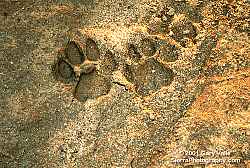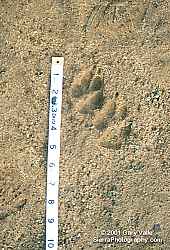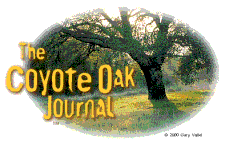 
Mountain Lion Tracks,
Simi Hills, Jan 2000
|
Mountain Lion Tracks
Friday, February 2, 2001
Copyright © 2001 Gary Valle'. All Rights Reserved.
There's a Santa Ana wind today and temps are warming back
up. More than a week has passed since it rained and the
ground is not nearly as muddy. That's good and bad. It's
good because my running shoes aren't getting so caked with
mud anymore, but it's bad because the damp ground is great
for looking at animal tracks.
|
Reading tracks can be very rewarding. The more you see the more
you learn, and the more you learn the more you see. It's another
aspect of the natural environment that gives you insight into
Nature's wholeness and interconnection.
These mountain lion tracks show
the round, clawless imprint typical of felines. A distinguishing
characteristic of feline tracks is the bilobed front edge
of the plantar pad.
Compare to these coyote
tracks, which are more oblong, have claw marks on the
two leading toes, and a more narrow, single lobed plantar
pad. In this photo the track of a hind foot is on the left,
and front foot is on the right. The hind is slightly smaller
and only shows the central area of the plantar pad. |
 
Coyote Tracks, Simi
Hills, Jan 2000
|
A book that I have found to be
an invaluable reference is Tracking
& the Art of Seeing : How to Read Animal Tracks & Sign by
Paul Rezendes. Another book I refer to frequently is Field
Guide to Mammal Tracking in North America by James
Halfpenny.
It saddens and angers me that the mountain lion that made
these tracks was killed in late 2004 by eating prey (coyote)
that had eaten rodents that had consumed anticoagulant based
poisons. These poisons are used by parks, schools, golf
courses and housing developments for rodent control. For
more information see "Deaths
of two mountain lions blamed on use of rodent poison."
For additional updates see the post Mountain
Lion Saga on my blog PhotographyontheRun.com.
For more info regarding mountain lions in Southern California,
see:
|




